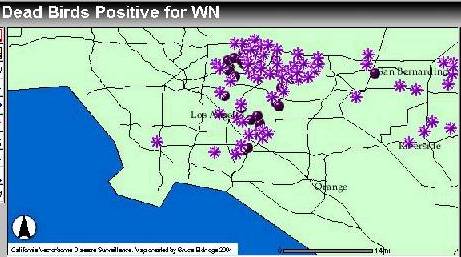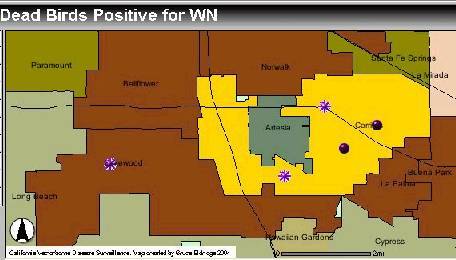






3853 Atlantic Ave.
|
Click here |
West Nile Virus Now Found In Dead Birds From Lakewood, Cerritos & Gardena As L.A. County Numbers Rise; Two Infected Mosquitoes Found South of El Monte; Officials Advise Taking Precautions
(May 30, 2004) -- Dead birds infected with West Nile Virus (WNV) that can cause serious illness and death in people (transmitted via infected mosquitoes) have been found in Lakewood, Cerritos & Gardena as numbers in L.A. County continue to rise (mainly in the San Gabriel Valley and southward down the San Gabriel river area.
Purple "X"s on the map below indicate dead birds recently testing positive for WNV (source: www.westnile.ca.gov, May 28, 2004).
We zoom into locations nearby LB below:
The maps on this page indicate info as of May 28; we also include a link below to updated information (recommended). Mosquitoes become infected with WNV when they feed on infected birds, and warmer temperatures bring more mosquitoes, increasing the likelihood of transmission to people. West Nile virus, common in Africa, west Asia and the Middle East, was first detected in the U.S. in New York in 1999 and has spread to 46 states, Canada and Mexico. Last year, there were almost 10,000 human cases of WNV detected, including 262 deaths in the U.S. In 2003, three WNV positive birds were found in LB. CA authorities also report that in the week ending May 28, 2004, two mosquitoes tested positive for WNV south of El Monte (map also below). A week earlier, two infected mosquitos were found near the The UC Davis Center for Vectorborne Diseases (CVEC) says the total WNV positive dead birds in L.A. County now totals 60...with a total of 157 dead bird carcasses with WNV collected in southern CA (L.A., Riverside, San Bernardino and Ventura Counties; none yet in OC). Health officials have advised taking precautions against the virus transmitted by mosquitoes (details below). On April 2, 2004 LB's Dept. of Health and Human Services issued a release "advising residents to take precautions against West Nile Virus (WNV)." It stated in pertinent part: Since WNV is spread by mosquitoes, local residents may provide valuable assistance in reducing local risk of the virus by eliminating standing water to prevent breeding of mosquitoes. The CA Nile Virus Surveillance Information Center at www.westnile.ca.gov states in part: Most people who are bitten by a mosquito with WNV will not get sick. People who do become ill may experience mild to moderate flu-like symptoms like fever, headache and body ache. It is estimated that less than 1% of the people who are infected with WNV become severely ill and require hospitalization. The elderly and immunocompromised are particularly susceptible to illness caused by WNV...Currently there is no specific treatment for WNV infection. Since it is a virus it does not respond to antibiotics. In severe cases hospitalization and supportive care is important. If you have symptoms of West Nile virus, call your doctor.For quick reference, we post the text of the www.westnile.ca.gov site's "Fast Facts" below (as found on May 22, 2004): FAST FACTS What is West Nile virus? • West Nile virus (WNV) is a mosquito-borne disease that is common in Africa , west Asia and the Middle East. When was West Nile virus first found in the United States ? • West Nile virus was first detected in the United States in New York in 1999. Since then, WNV has spread to 46 states, Canada , and Mexico . Has West Nile virus been detected in California ? • In 2003, three locally acquired human WNV cases were detected in residents of Los Angeles , Imperial, and Riverside counties, and WNV activity was detected in dead birds, mosquitoes, sentinel chickens, and a horse in six southern California counties. West Nile virus has also been detected in 2004 in southern California . How many human cases of West Nile virus were found in 2003? • Last year there were almost 10,000 human cases of WNV detected, including 262 deaths in the United States . How does someone get West Nile virus? • People usually get WNV from the bite of an infected mosquito. There is also evidence that WNV can be acquired via a blood transfusion or organ transplant from an infected donor. What are the symptoms and treatment? • Most people who are bitten by a mosquito with WNV will not get sick. People who do become ill may experience mild to moderate flu-like symptoms like fever, headache and body ache. It is estimated that less than 1% of the people who are infected with WNV become severely ill and require hospitalization. The elderly and immunocompromised are particularly susceptible to illness caused by WNV. • Currently there is no specific treatment for WNV infection. Since it is a virus it does not respond to antibiotics. In severe cases hospitalization and supportive care is important. • If you have symptoms of West Nile virus, call your doctor. How can people protect themselves? • Avoid spending time outside at dawn and dusk when mosquitoes are active. They are especially active for two hours after sunset. • When outdoors, wear long pants, long sleeve shirts and other protective clothing. • Apply insect repellent containing DEET according to label instructions. • Make sure that doors and windows have tight fitting screens. Repair or replace screens that have tears or holes. • Eliminate all sources of standing water that can support mosquito breeding. What are state and local agencies doing to control the spread of West Nile virus? • California has a long history of conducting surveillance for mosquito-borne viruses and has taken active steps to ensure early detection of WNV. Due to ongoing collaboration between over 70 local mosquito and vector control agencies and state public agencies, California is well prepared to detect, monitor, and respond to WNV. These agencies use a variety of scientific techniques and products to control mosquitoes in their earliest stages and play a key role in reducing the risk of WNV. Also California has launched a statewide public education effort about personal protection measures and reporting dead birds. Why is the public urged to report dead birds? • The public is encouraged to assist in the efforts to detect and monitor WNV by calling the WNV hotline if they find a crow, raven, magpie, jay, sparrow, finch, or hawk that has been dead for about a day. Birds play an important role in maintaining and spreading this virus. Mosquitoes acquire the virus from infected birds, and then transmit the virus to people. Evidence of the virus in dead birds is often the first indication that WNV has been introduced into a new region. DHS has set up a toll free hotline for the public to report dead birds: 877-WNV-BIRD or click HERE. • For more information on West Nile virus, visit the Web site: http://www.cdc.gov/ncidod/dvbid/westnile/q&a.htm For updated information, we recommend going to: CA West Nile Virus Surveillance Center and click on "Detailed WNV Maps and Surveillance Data from UC Davis." Contact us: mail@LBReport.com |

